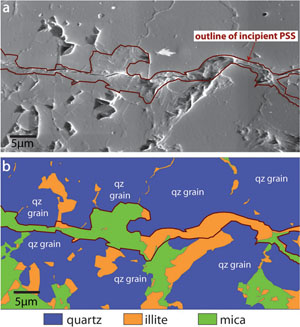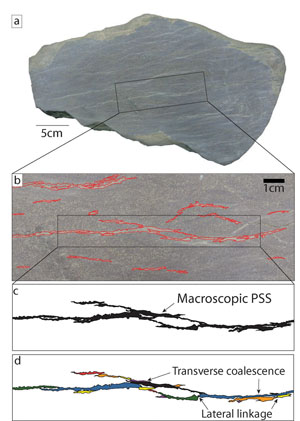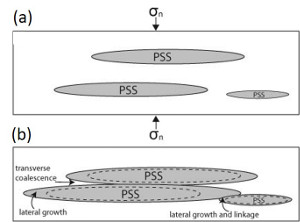| |||||||
|
|
|||||||
|
|
|||||||
| Growth of Pressure Solution Seams | |||||||
|
Under 'Initiation of Pressure Solution Seams' and 'Propagation of Pressure Solution Seams,' we have drawn some parallels between PSSs and joints, the most significant of which was that similar to joints, pressure solution seams also have significant stress concentrations around their sharp tips. The tip stresses associated with PSSs are compressive and may be sufficient to derive the lateral growth of PSSs in their own planes although a specific propagation criterion is presently lacking. However, the intensity of the stress concentration at the tip areas of a PSS does not appear to be as strong as that around a joint with a similar size subjected to the same stresses but with opposite signs. In addition, the neighboring grain boundaries may not be perfectly aligned or may not even be in hard contact all the way, which is different than, for example, a single joint transecting across multiple grains or crystals. These subjects are not well understood but it appears that the in-plane propagation of PSSs can occur in a limited extent due to their tip stresses alone. Similarly, analogous to the lateral growth of joints and faults, the most crucial process of PSSs' lateral growth is the linkage of neighboring PSSs whose tips are in close proximity in microscopic as well as macroscopic scale. Figure 1 shows an incipient pressure solution seam in detrital rock going through several grain boundaries. It is reasonable, based on the observation of isolated intergranular pressure solution confined between two grains only, to envisage that the initial growth of the structure going through multiple grain boundaries occurred by the linkage of the intergranular pressure solution seams along neighboring grain boundaries either in-plane or slightly off-plane. Figures 2 and 3 show arrays of PSSs on a sample's surface which was cut and polished (a). The central area of the sample (marked by a rectangle) has been mapped in (b). One of the macroscopic PSSs within the rectangle in (b) is isolated and enlarged in (c). Based on the gaps and overlaps between parts of this structure and some traces splaying off of the main trace, it is possible to identify several segments in (d), which make up a compound PSS. This image along with microscopic images of intergranular PSSs provided under the 'Initiation of Pressure Solution Seams' supports the notion that most if not all PSSs are segmented and their growth occurs through the linkage of the neighboring segments. This conclusion should be no surprise for those who are familiar with the growth of other discontinuities such as joints and faults by linkage of adjacent segments as noted earlier in this Knowledgebase (see 'Growth of Joints' and 'Growth of Faults'). Also see 'Mechanisms and Mechanics of Pressure Solution Seams' for further rationale for the linkage mechanism. Regarding the transverse growth of PSSs, there are two major differences between the growth process of a pressure solution and a joint. The transverse growth of a joint is quite straight-forward and is reflected in the mechanical aperture. However, the transverse growth of a pressure solution seam is rather complex due to a variety of factors: (1) the structural inhomogeneity introduced by a seam, (2) complex boundary geometry and possible transverse enlargement, (3) transverse coalescence of subparallel seams, and (4) stress distribution at a PSS's flanks different than stress-free state of the joint surfaces. Here, it suffices to provide a schematic diagram (Figure 3) illustrating the lateral and transverse linkage and coalescence of neighboring PSSs. The PSSs commonly grow into a set with individual seams subparallel to each other as noted under the PSS Sets. Several examples of the PSS sets can be seen in Figures 1 to 4 under 'Pressure Solution Seam Sets,' Figure 1 under 'Spacing of Pressure Solution Seams,' under 'Pressure Solution Seams,' Figure 1, and under 'Stylolites,' Figure 1. The stylolite sets divide the rock into what is called mechanical layers which are the slabs between relatively continuous solution seams. These mechanical layers typically range between 1 cm and 3 m in thickness in outcrops and play an important role in controlling the development of subsequent structural elements. Graham et al. (2003) and Safaricz and Davison (2005) described formation of extensive bedding-parallel pressure solution seams in carbonate rocks and Nenna and Aydin (in review) documented PSS sets in detrital rocks. The last two studies also documented zonal occurrence of PSSs. The concept of a PSS set brings about important notions of the evolution of length and thickness of individual members and the evolution of PSS spacing. The conceptual model in Figure 4 assumes that (1) individual PSSs may be able to grow in-plane and they may be able to thicken perhaps with a little help from the asperities on their flanks and that (2) the major growth processes are lateral linkage and transverse merger of the adjacent PSSs. These processes should be strongly influenced by the stress state around PSSs and the interaction among neighboring PSSs. Please see 'Mechanics and Mechanisms of Pressure Solution Seams,' 'Initiation of Pressure Solution Seams,' 'Propagation of Pressure Solution Seams,' and 'Interaction of Pressure Solution Seams' for further information on this topic and length, thickness, and spacing distribution of PSSs.
| |||||||
| Reference: |
|||||||
| Graham Wall, B., Antonellini, M., Aydin, A., 2002 Graham Wall, B., Antonellini, M., Aydin, A., 2003 Nenna, F., Zhou, X., Aydin, A., 2010 Nenna, F., Aydin, A., 2011 Safaricz, M., Davison, I., 2005 Zhou, X., Aydin, A., 2012 |
|||||||
|
Readme | About Us | Acknowledgement | How to Cite | Terms of Use | Ⓒ Rock Fracture Knowledgebase |
|||||||



